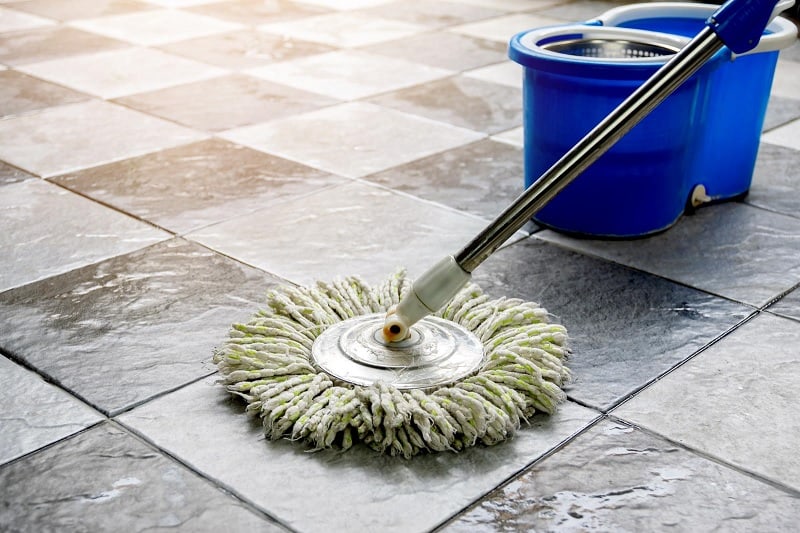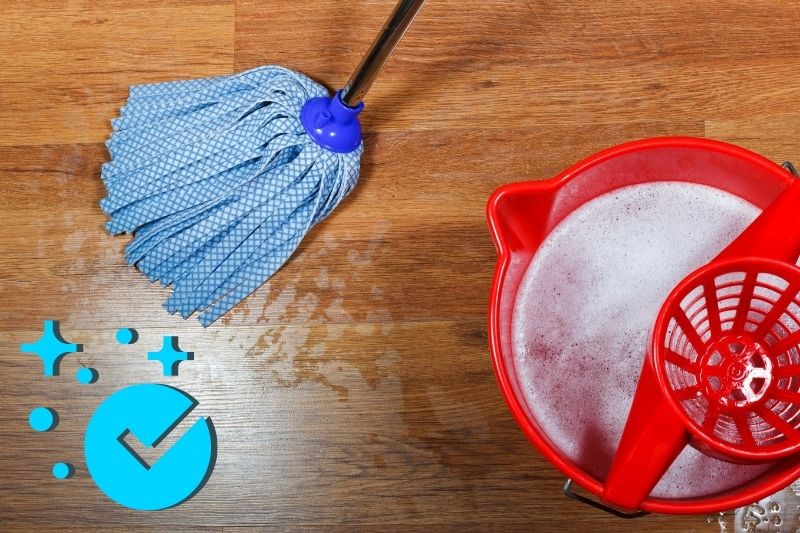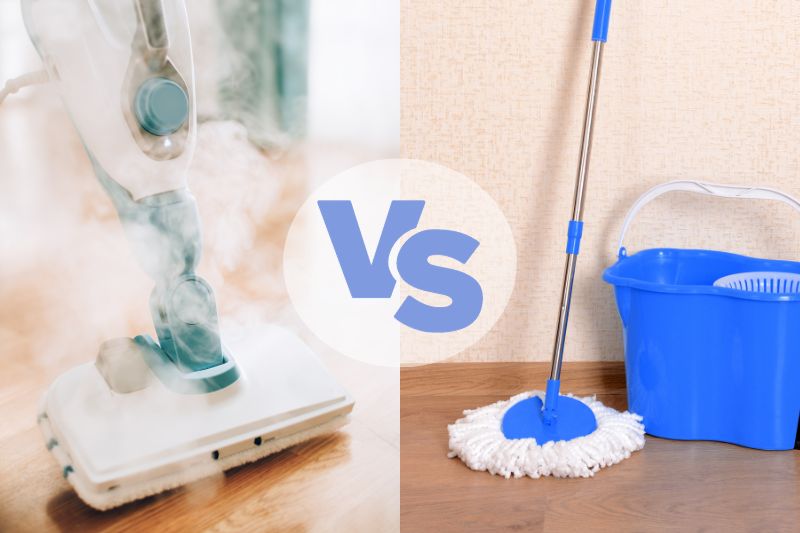The choice between a steam mop and a regular mop has become a hot topic of debate. While both share the common goal of achieving sparkling floors, they each bring their own set of advantages and limitations to the chore. But which is best?
Join us as we compare both mop types and help you decide which option is better for your household chores.
Which Is the Most Convenient to Use?
Steam mops are generally easier to use than regular mops. You fill the water tank, wait for it to heat up, and then start cleaning.
There’s no need to carry around a bucket of water or wring out a mop head, and the results of your cleaning have nothing to do with the amount of elbow grease you put in—the steam does all the hard work for you.
On the other hand, standard mops rely on you lugging around a heavy bucket of water.
You will need to replace the water regularly, depending on the size of the area you’re cleaning.
Without the power of stream, you may have to mop dirty floors several times to achieve a spotless finish.
Winner: Steam mop
Which Is Better for the Environment?
Traditional mops don’t require electricity to operate, which means they have a lower energy consumption footprint.
Regular mop handles and mop heads can also be more durable, reducing the frequency of replacement and lowering the manufacturing impact on the planet.
However, standard mops often rely on chemical cleaning agents, which may contain harmful ingredients that can impact indoor air quality and contribute to water pollution when disposed of.
Additionally, some traditional mop systems use disposable mop heads or pads, which can generate more waste over time and negatively impact the environment.
Unfortunately, steam mops aren’t perfect, either. The production of steam mop devices involves using materials and energy, which can have an environmental impact.
However, steam mops are generally seen as the more eco-friendly option for the following reasons:
- Reduced chemical usage: Steam mops typically require only water for cleaning, reducing the need for chemical cleaning agents. This can be more environmentally friendly, as it decreases the use of potentially harmful chemicals polluting the planet.
- More energy efficient: While steam mops do require electricity to generate steam, they are generally considered energy-efficient because they use relatively small amounts of power for short periods. They also use less water than regular mops.
- Minimal waste: Steam mops produce less waste compared to disposable mop pads or disposable mop heads used with traditional mops. Properly caring for your steam mop can also extend its lifespan to reduce the need for replacements.
Winner: Steam mop
Which Is Best for Mopping Up Spills?
Steam mops can be highly effective at cleaning up spills, especially sticky or greasy ones. The steam can help loosen and dissolve spills, making them easier to wipe away in a simple sweeping motion.
However, steam mops aren’t as effective at cleaning up liquid-based spills. As these mops produce moisture in the form of steam, your floor may get wetter.
In comparison, regular mops are designed with highly absorbent materials. This makes them effective at soaking up liquid spills.
Regular mops are also effective in tackling sticky or greasy spills: mop the floor using water and detergent to rid these spills goodbye.
Winner: Regular mop

Which Is Best for Sanitising Floors?
Steam mops are generally better at sanitising floors compared to regular mops for several reasons:
- High-temperature steam: Steam mops use hot steam (typically 120°C) to clean surfaces. The high heat effectively kills many common household bacteria, germs, and even some viruses. This makes steam mops an excellent choice for achieving a high level of sanitisation.
- Continuous cleaning: Steam also mops provide a continuous flow of steam, ensuring that the surface remains in contact with the high-temperature steam for an extended period. This prolonged exposure contributes to effective sanitisation.
Regular mops can also effectively clean floors, but they may not provide the same level of sanitisation as steam mops.
The sanitation level of regular mops largely depends on the cleaning agents used and the thoroughness of the cleaning process.
Chemical disinfectants can effectively sanitise your floors, but they may leave residues that need to be rinsed or wiped away.
Winner: Steam mop
Which Can Be Used on More Surfaces?
Steam mops can be used on a variety of hard, sealed surfaces. Examples include tiles (ceramic, porcelain, and natural stone), sealed hardwood flooring, and concrete.
However, steam mops are not suitable for all types of flooring. The steam can penetrate unsealed surfaces, causing warping, swelling, and other signs of damage.
You should be cautious when using a steam mop on the following floor types:
- Unsealed hardwood
- Engineered wood with a thin veneer
- Laminate flooring
- Solid hardwood
- Sheet vinyl and vinyl plank flooring
- Karndean flooring
In comparison, regular mops can be used on many surfaces, including cleaning laminate, hardwood, tile, and vinyl.
You can control the amount of water you use and adjust it based on your needs. They are also not limited to floors and can be used for other cleaning tasks, such as walls and ceilings.
Winner: Regular mop

Which Dries Quicker?
The amount of water left after mopping is a crucial factor to consider. One of the most annoying things about mopping floors is waiting for them to dry afterwards, and the dryer the floor initially, the quicker the drying process.
Excess water left behind can also cause unsightly streaks across the flooring.
When used correctly, regular mops introduce less moisture to the floor compared to steam mops.
You can wring out the mop head to control the level of dampness, making it possible to leave the floor relatively dry or just slightly damp, depending on your preference.
However, while more moisture is introduced to the floor using a steam mop, it evaporates quickly due to the high temperature.
Ultimately, the degree of wetness left on the floor can be adjusted with proper technique and usage.
Still, steam mops usually leave your floor dryer once you’re finished, even though they actually make the floor wetter during the cleaning process.
Winner: Steam mop
Which Is More Affordable?
Regarding upfront costs, regular mops are more affordable than steam mops. High-quality steam mops can be relatively expensive, whereas a traditional mop and bucket can be purchased for £25 or less.
However, ongoing costs also need to be considered, such as the price of:
- Mop heads: Traditional mop heads are made of materials like cotton or microfibre, which are reusable and can last a significant amount of time if properly maintained. In comparison, many steam mops use disposable or replaceable microfiber pads, which need to be replaced more frequently.
- Cleaning products: Traditional mops are best used with cleaning solutions, which can vary in price depending on the brand and type of cleaner you choose. You only need a small amount for each use, so this won’t be a significant ongoing investment. Steam mops don’t rely on cleaning products, so this cost is £0.
- Electricity: You will need to consider the electricity required to operate a steam mop, as the appliance consumes energy to heat the water and produce steam. While not a significant ongoing cost for steam mop users, traditional mops and buckets don’t contribute to your electricity bills whatsoever.
Steam mops have a higher initial investment cost than regular mops, making regular mops the more affordable option upfront.
The cost of cleaning products and mop head replacements for standard mops can add up over time. Nevertheless, they’re generally more affordable.
Winner: Regular mop

Steam Mop vs Regular Mop – The Verdict
To help you choose whether a steam mop or a regular mop is the right choice for you, here is a quick look back over the advantages of each:
Benefits of steam mops:
- No chemical cleaners: Steam mops use steam to clean floors. They can be highly effective at removing stubborn stains, dirt, and grime without the need for chemical cleaners.
- Sanitisation: Steam mops are known for their ability to kill many common household bacteria and germs, making them a good choice for households with health concerns or allergies.
- Convenience: Steam mops are generally easier to use than traditional mops. Fill the water tank and wait for it to heat up before mopping your floors—there’s no bucket in sight!
- Quick drying: Since steam mops use hot steam, the floors usually dry faster than when using a traditional mop and bucket due to evaporation.
- Environmentally friendly: Steam mops are energy-efficient appliances and reduce the need for chemical cleaners, which can be more environmentally friendly.
Advantages of regular mops:
- Versatility: Regular mops can be used on almost all hard surfaces in your home. They can clean everything from tiles to vinyl, laminate, hardwood, concrete, and more.
- Affordability: Traditional mops are generally more affordable upfront than steam mops, which may require a significant initial investment.
- Control: With a regular mop, you have more control over the amount of water you use, making it suitable for delicate flooring types or areas where excess moisture is a concern.
- Durability: Traditional mops have a longer lifespan than steam mops, which can be more prone to wear and tear due to the heating elements and electronic components.
- Maintenance: Traditional mops are generally easier to maintain and clean since they don’t have complex internal components.
Ultimately, choosing what to mop floors with depends on your specific cleaning requirements and personal preferences.
A steam mop may be the better option if you prioritise sanitisation, convenience, and speed.
However, a regular mop could be the way to go if you prefer versatility and more control over the cleaning process.
Why not get both if you can’t decide between purchasing a steam mop and a regular mop? Many people choose to have both on hand for different cleaning tasks in their homes. You can view the best mop and bucket sets and best steam cleaners in our roundup guides.

Hannah has a passion for cleaning. She worked her way around Australia by cleaning hostels in exchange for free accommodation and used her cleaning skills to bag a job as a chalet host for a luxury ski company in France.






